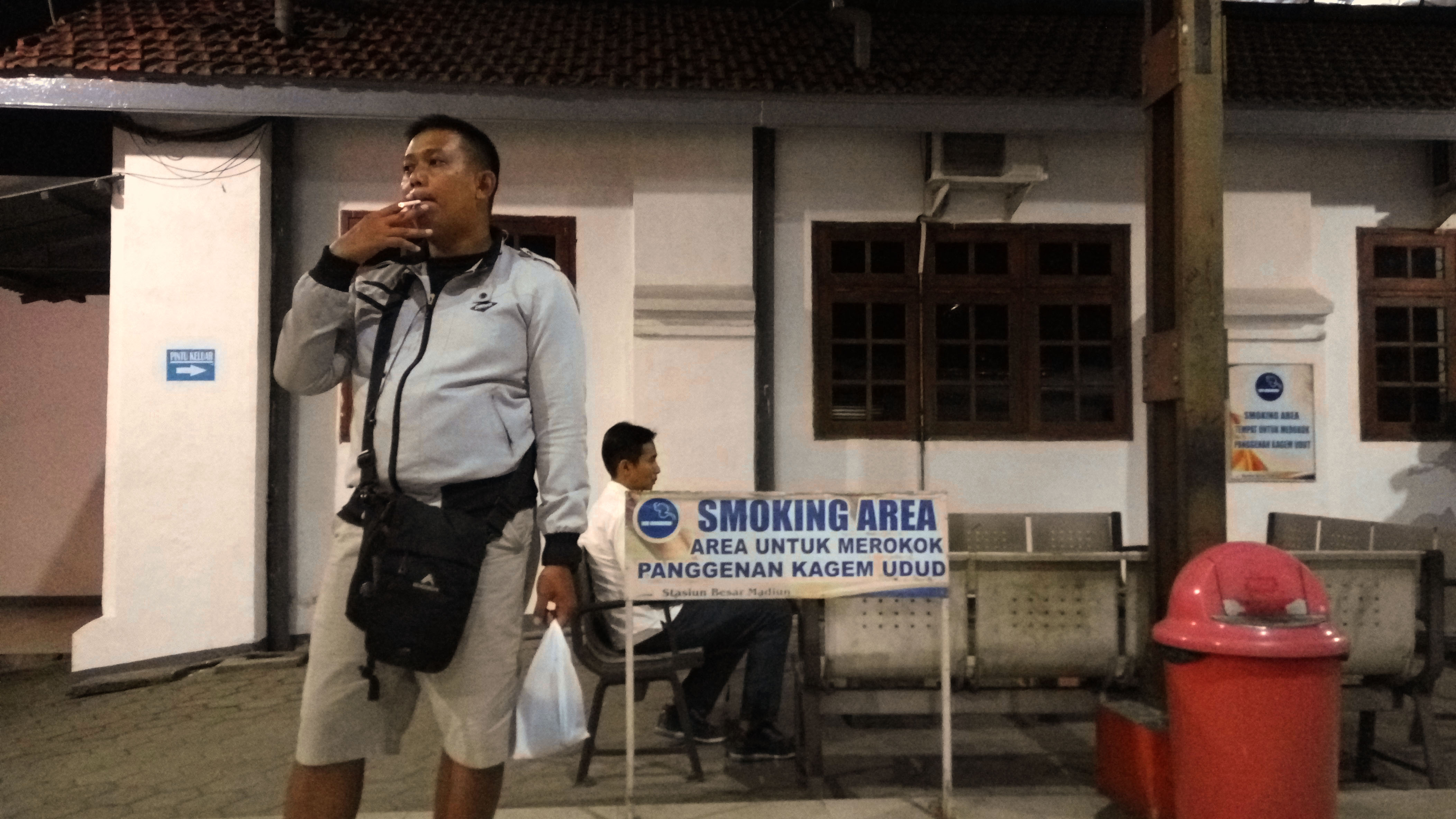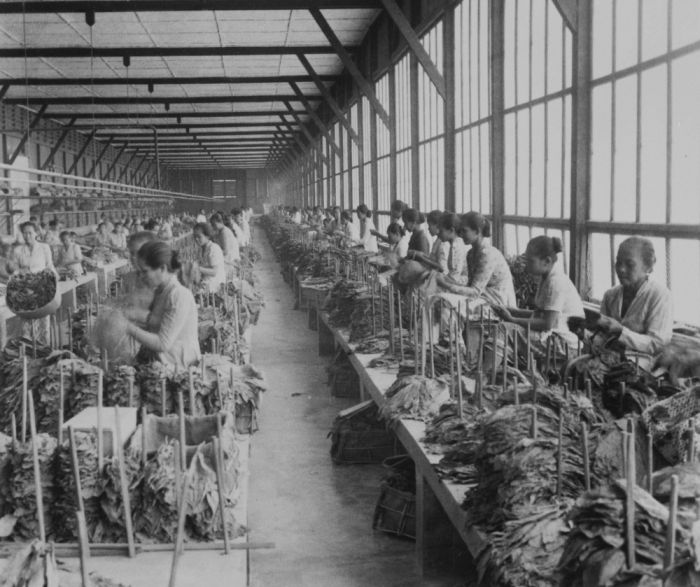Smoking in Indonesia
[[File:Template:Ambox globe current red|42px|link=]] | This article needs to be updated. (September 2022) |


Smoking in Indonesia is common, as there are approximately 57 million smokers in Indonesia.[1] Of Indonesian people, 63% of men and 5% of women reported being smokers, a total of 34% of the population.[2] 88% of Indonesian smokers use clove-flavoured kreteks.[2] Kretek manufacturers directly employ over 180,000 people in Indonesia and an additional 10 million indirectly.[3] Indonesia is the fifth largest tobacco market in the world, and in 2008 over 165 billion cigarettes were sold in the country.[2]
Major tobacco companies dominating the market in Indonesia according to the year of establishment include:
- HM Sampoerna (Philip Morris International, 1913), in the first place.
- Bentoel International Investama (British American Tobacco, 1930), in the second place.
- Nojorono Tobacco International (1932), in the third place.
- Djarum (1951), in the fourth place.
- Gudang Garam (1958), in the fifth place.
- Wismilak Inti Makmur (1962), in the sixth place.
- Tri Sakti Purwosari Makmur (1974), in the seventh place.
- Indonesian Tobacco (1980), being the eighth and the last place.[4]
The WHO has ranked Indonesia third in the world for total number of smokers.[5]
Kretek cigarettes

Kretek is credited as an invention by Nitisemito of Kudus, an industrial town in Central Java. They emerged in the late 19th century in Java. The practice was to roll, by hand, a compound of tobacco, cloves and cocoa in a dry corn husk wrap, which gives a honeyed flavour. It was Nitisemito who introduced cigarette papers in place of corn husk; following this simple innovation, a Kretek manufacturing factory was opened in Sumatra. The first brand of cigarette produced in this factory, "Bal Tiga" (three balls), became very popular, and as result, the economy of Kudus prospered.[6]
The inventor popularized his brand of cigarettes through a concerted media campaign, even establishing his own radio station for the purpose.Template:Fix/category[citation needed] He touted his habit of smoking kretek as the cure for his asthma. Intense competition (25 manufactures are now reported in the city and its suburbs) combined with poor management resulted in his eventual financial failure, when he died in 1953.[6] Another brand is Gudang Garam, founded by Chinese Indonesian businessman Surya Wonowidjojo.[7] It has the distinction of being the largest single employer in Indonesia.[8]
Kretek is very popular in rural areas as this type of cigarette is cheap. Kretek is known to burn slowly, and also self-extinguish.[9] Evidence seems to suggest oral lesions may be less common than with other cigarette types. Due to this effect, cigarette smoking has largely replaced betel chewing.[10]
The term "Kretek" is onomatopoeic, referring to the crackling sound that is produced when such cigarettes are burnt and inhaled.[6]
Kretek cigarettes contain high concentration of tar and nicotine, approximately four times that of the strongest Marlboros.[11] Some countries (such as the United States) have banned marketing flavoured cigarettes (including kreteks), as these are often seen as more appealing to the youth.[12] The other harmful effect mentioned is from the clove oil used in making Kretek. The clove oil or eugenol is harmful to the lungs. The Indonesian Health Department reported in 2000 that 200,000 people are affected by cancer every year but eugenols exact relation to smoking has not been evaluated. Due to the popularity of Kretek, 5% of the national revenue is from this source, next only to the revenue from oil. Indonesia also records the highest growth of cigarette industry in the world, accounting for 4% of the world consumption.[6]
While cigarette smoking is declining throughout the world, in Indonesia, the industry continues to thrive. Indonesia has one of the highest smoking rates in the world and is currently one of the biggest producers of tobacco worldwide,[13] with Malaysia and the United States being two of their important markets.[14] There are hundreds of tobacco companies in the country, with Gudang Garam, Djarum, Sampoerna, Bentoel and Wismilak dominating the Indonesian market share.[11]
Kretek was initially a habit of the lower classes of society. However, it has now become very popular among the "middle class and intelligentsia, to the extent that it has become very de rigueur and a mark of Indonesian-ness."[8]
Harmful effects and regulations
Tobacco smoking in Indonesia is said to claim 300,000 lives every year.[15] Even though Indonesia has required "no smoking" signs in health care units, educational institutions and in public transportation system, there is no ban on smoking in government and private offices, restaurants and bars. Tax exemptions in Indonesia provide an incentive to the manufacturers to advertise the sale of cigarettes as compared to other countries in the region, in spite of the World Bank suggesting higher tax rates. As a result, tobacco manufacturers almost run cigarette advertisements for free. All these factors, plus its low cost, have contributed to the extensive proliferation of cigarette smoking in Indonesia among people of all ages.[2]
So much so, that even a two-year-old child picked up the habit of smoking two packs of cigarettes a day in his fishing village, where every one smokes. It was reported that the child's grandfather initiated his son into this habit at the age of 18 months. However, press reports indicate that the child has been placed in rehabilitation by keeping him in a different environment under the care of a psychologist, and as a result the child has given up smoking.[16] The government of Indonesia is now contemplating introducing regulations that would ban the advertising of cigarettes, smoking in public places and selling cigarettes to children.[5]
Main issues
Cigarette advertisements
Unlike the rest of the world, cigarette advertising are still allowed in Indonesia,[17] and as of 2021, Indonesia is the only country in the world to allow cigarette advertising.[18] However, it is prohibited to show cigarettes and advertising must include smoking warning messages. In Indonesia itself, such advertisements known under the name iklan rokok in Indonesian. In 2003, cigarette advertising and promotions in Indonesia was valued at $250 million.[19] In addition to television and outdoor advertisements, sporting events sponsored by cigarette brands or companies also occur.[20]
Child smoking
According to an official spokesman of a special commission set up to protect children's rights (KPAI) and evolve regulations to prevent children getting addicted to smoking, "The future of 80 million Indonesian children is at stake as the cigarette producers were intentionally aiming children as their future market through massive TV advertisements and sponsorships on activities in which teenagers involved the most."[5]
More than 30% of Indonesian children reportedly smoke a cigarette before the age of 10.[21] In 2010, a two-year-old boy from Sumatra, Ardi Rizal, made global headlines for having a 40-a-day cigarette habit.[21][22]
In 2003, cigarette advertising and promotion in Indonesia was valued at $250 million.[23] It is thus one of the most distinctive tobacco manufacturing hubs in the world. Smoking Kretek is said to be "an ingrained part of Indonesian culture". An all pervading scent of kretek smoke is distinctly discerned in Indonesia.[14]
Gallery
- Smoking in Indonesia
A row of A Mild advertisements (lower right) near Samarinda Central Plaza, Samarinda, East Kalimantan.
Street view in Singaraja, Bali, with a Djarum Super Compact Size advertisement in the far right, captured in 2005.
References
- ↑ "Tobacco Economics in Indonesia" (PDF). International Union Against Tuberculosis and Lung Disease. 2008. Archived from the original (PDF) on January 10, 2017. Retrieved March 8, 2012.
- ↑ 2.0 2.1 2.2 2.3 "Indonesia". Tobacco Free Center. Archived from the original on June 11, 2010. Retrieved September 3, 2010.
- ↑ Hanusz, Mark Smoke; A Century of Kretek pp. 140-143
- ↑ "Country Report: Tobacco in Indonesia". Euro Monitor. August 2011.
- ↑ 5.0 5.1 5.2 "Indonesia struggling to deter children from smoking". People’s Daily Online. 2010-08-30. Retrieved 2010-09-06.
- ↑ 6.0 6.1 6.2 6.3 Backshall, Stephen (2003). The Rough Guide to Indonesia. Rough Guides. p. 266. ISBN 1-85828-991-2. Retrieved 2010-09-06.
- ↑ Leo Suryadinata. Prominent Indonesian Chinese: Biographical Sketches. Institute of Southeast Asian Studies, 1995.
- ↑ 8.0 8.1 Eliot, Joshua; Liz Capaldi; Jane Bickersteth (2001). Indonesia handbook, Volume 3. Footprint Travel Guides. p. 244. ISBN 1-900949-51-2. Retrieved 2010-09-06.
- ↑ Gupta, Praksh C. (1992). Control of tobacco-related cancers and other diseases: proceedings of an international symposium, January 15–19, 1990, TIFR, Bombay. Prakash C. Gupta. p. 16. ISBN 0-19-562961-2. Retrieved 2010-09-06.
- ↑ Macleod, Mudo J.; Evelyn Sakakida Rawski (1998). European intruders and changes in behaviour and customs in Africa, America, and Asia before 1800: Snippet View. Ashgate. ISBN 0-86078-522-X. Retrieved 2010-09-06.
- ↑ 11.0 11.1 Reynolds, Catherine (1 March 1999). "The fourth largest market in the world". Tobacco Control. 8 (1): 89–91. doi:10.1136/tc.8.1.89. ISSN 0964-4563. PMC 1763937. PMID 10465825.
- ↑ Delnevo, Cristine D.; Hrywna, Mary (1 December 2015). "Clove cigar sales following the US flavoured cigarette ban". Tobacco Control. 24 (e4): e246–e250. doi:10.1136/tobaccocontrol-2013-051415. ISSN 0964-4563. PMID 24652459. S2CID 207035108.
- ↑ Danubrata, Eveline; Beo Da Costa, Agustinus (30 March 2017). "Exclusive: Indonesia eyes decree on tobacco after bill runs into opposition". Reuters. Retrieved 19 May 2018.
- ↑ 14.0 14.1 The Report: Indonesia 2009. Oxford Business Group. 2009. p. 123. ISBN 978-1-907065-05-7. Retrieved 2010-09-06.
- ↑ Endah Hapsari (May 30, 2012). "'Pembunuh Sadis' Ini Menewaskan 300 Ribu Orang Tiap Tahun" (in Indonesian). Republika Online. Retrieved 2013-08-10.
{{cite web}}: CS1 maint: unrecognized language (link) - ↑ "Indonesia's smoking toddler kicks the habit". The Associated Press. September 3, 2010. Archived from the original on 2010-09-06. Retrieved 2010-09-06 – via Yahoo! News.
- ↑ "Indonesia". Tobacco Control Laws. Retrieved December 25, 2020.
- ↑ Vania Rossa; Dini Afrianti Efendi (November 10, 2021). "Jelang HKN 2021, Indonesia Jadi Satu-Satunya Negara di Dunia yang Izinkan Iklan Rokok". Suara.com (in Bahasa Indonesia). Retrieved November 12, 2021.
- ↑ Tony Sitathan (July 11, 2003). "Indonesia: Smoke, Smoke, Smoke that Cigarette". Asian Times. Archived from the original on August 2, 2003. Retrieved September 3, 2010.
{{cite news}}: CS1 maint: unfit URL (link) - ↑ Gloria Setyvani Putri (September 9, 2019). "Menurut WHO, Djarum Memang Tidak Boleh Sponsori Event Olahraga". Kompas.com (in Bahasa Indonesia). Retrieved December 25, 2020.
- ↑ 21.0 21.1 "Toddler Who Smoked 40 a Day Kicks Habit". Yahoo! News. Archived from the original on September 5, 2010. Retrieved September 3, 2010.
- ↑ Jewel Topsfield, Indonesia's 'smoking baby' kicked his habit but the battle against tobacco rages on Sydney Morning Herald, June 17, 2017
- ↑ "Indonesia: Smoke, smoke, smoke that cigarette". Asian Times. July 11, 2003. Archived from the original on August 2, 2003. Retrieved September 3, 2010.
{{cite web}}: CS1 maint: unfit URL (link)
External links
- Tobaccoland, a Vice documentary on the total lack of tobacco regulations in Indonesia.
- CS1 maint: unrecognized language
- CS1 Bahasa Indonesia-language sources (id)
- CS1 maint: unfit URL
- Articles with short description
- Wikipedia articles in need of updating from September 2022
- Articles with invalid date parameter in template
- All Wikipedia articles in need of updating
- Articles containing Indonesian-language text
- Indonesian culture
- Health in Indonesia
- Smoking by country
- Tobacco in Indonesia


